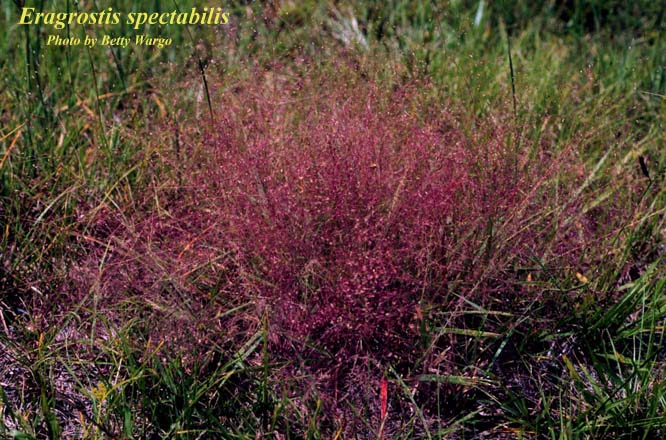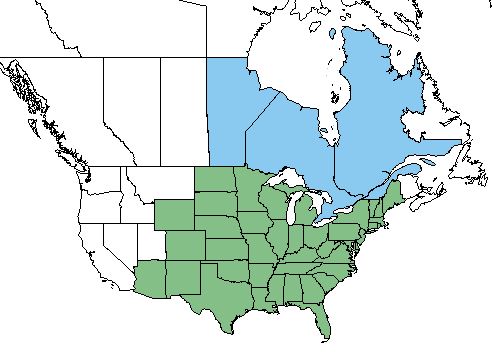Eragrostis spectabilis
Common Names: purple lovegrass [1], showy love grass [2], tumblegrass [3]
| Eragrostis spectabilis | |
|---|---|

| |
| Photo by the Atlas of Florida Plants Database | |
| Scientific classification | |
| Kingdom: | Plantae |
| Division: | Magnoliophyta - Flowering plants |
| Class: | Liliopsida - Moncots |
| Order: | Poales |
| Family: | Poaceae |
| Genus: | Eragrostis |
| Species: | E. spectabilis |
| Binomial name | |
| Eragrostis spectabilis Pursh | |

| |
| Natural range of Eragrostis spectabilis from USDA NRCS Plants Database. | |
Contents
Taxonomic Notes
Synonyms: Eragrostis spectabilis (Pursh) Steudel var. spectabilis; E. spectabilis (Pursh) Steudel var. sparsihirsuta (Farwell); E. pectinacea (Michaux) Nees ex Steudel
Description
E. spectabilis is a perennial graminoid that is a member of the Poaceae family native to North America.[1] Generally reaches heights between 1 and 3 feet with leaf blades 8 to 18 inches in length. Leaves densely hairy, taper to a fine point, and are stiffly ascending when they are young. Sheath of the leaf is longer than the internodes, and covered with long grey hair. Hairy ligule; seedhead is an open panicle which is bright purple when mature. Tuft of hair located in axial of seed stalks, and spikelets range from 6 to 12 flowers.[4]
Distribution
E. spectabilis is found throughout the majority of the 48 continental United States excepting the far west. It has also been introduced to eastern Canada. [1]
Ecology
Habitat
Ideal habitats for E. spectabilis are sandy fields, roadsides, and woodlands.[5] Habitats that this species has also been observed in include wet pine flatwoods, dry sand open field, sandy vacant lots, pine woodlands, dry woods, upland pine oak woods, coarse sand regions with scrub barrens, and other disturbed areas such as roadsides and parking lots.[6] Soils that this species is mostly adapted to include medium- and coarse-textured soils.[4] It grows most abundantly on moist and sandy soil that is in full sun.[7]
Phenology
Generally, this species flowers from August until October.[5]
Seed dispersal
This species is thought to be dispersed by gravity.[8] The weak seedheads at the top of the grass stalks will break off and get dispersed by the wind as well.[4]
Fire ecology
Controlled annual burning is beneficial to the grass; it will increase if the region is annually burned.[4]
Use by animals
E. spectabilis consists of approximately 2-5% of the diet for various terrestrial birds.[9] It is used by livestock for grazing in the spring. Deer will dig up the basal part of the stem and eat it during the winter. [4] This species is also highly deer resistant.[7]
Conservation and Management
This species is considered to have weedy or invasive characteristics according to Nebraska and the Great Plains region.[1] E. spectabilis is not a key management species since it is usually not abundant enough, but can add a variety to the diet of livestock. Maximum production is reached if no more than 50% of the current year's growth is grazed by livestock, and to improve plant vigor, grazing in the summertime should be deferred for at least 90 days.[4]
Cultivation and restoration
Photo Gallery
References and notes
- ↑ 1.0 1.1 1.2 1.3 USDA Plant Database
- ↑ Battaglia, L. L., et al. (2002). "Sixteen years of old-field succession and reestablishment of a bottomland hardwood forest in the lower Mississippi alluvial valley." Wetlands 22(1): 1-17.
- ↑ Robertson, K. R., et al. (1997). Delineation of natural communities, a checklist of vascular plants, and new locations for rare plants at the Savanna Army Depot, Carroll and Jo Daviess Counties, Illinois. Champaign-Urbana.
- ↑ 4.0 4.1 4.2 4.3 4.4 4.5 USDA Plant Database Cite error: Invalid
<ref>tag; name "fact" defined multiple times with different content - ↑ 5.0 5.1 Weakley, A. S. (2015). Flora of the Southern and Mid-Atlantic States. Chapel Hill, NC, University of North Carolina Herbarium.
- ↑ URL: http://herbarium.bio.fsu.edu. Last accessed: June 2018. Collectors: Loran Anderson, Cecil Slaughter, R.K. Godfrey, John Nelson, Gary Knight, H. Kurz, Robert Lazor, A.f. Clewell, George Cooley, Erdman West, Tom Daggy, R.E. Perdue Jr., A.H. Curtiss, Sidney McDaniel, R.Norris, R.Komarek, Karen MacClendon, Floyd Griffith) States and counties:Florida (Wakulla, Flagler, Franklin, Leon, Liberty, Gilchrist, Taylor, Bay, Palm Beach, Levy, Duval, Lafayette, Calhoun, Indian River, Washington, Holmes) Georgia (Thomas, Grady, Clinch, Atkinson)
- ↑ 7.0 7.1 [[1]] Lady Bird Johnson Wildflower Center. Accessed: May 8, 2019
- ↑ Kirkman, L. Katherine. Unpublished database of seed dispersal mode of plants found in Coastal Plain longleaf pine-grasslands of the Jones Ecological Research Center, Georgia.
- ↑ Miller, J.H., and K.V. Miller. 1999. Forest plants of the southeast and their wildlife uses. Southern Weed Science Society.